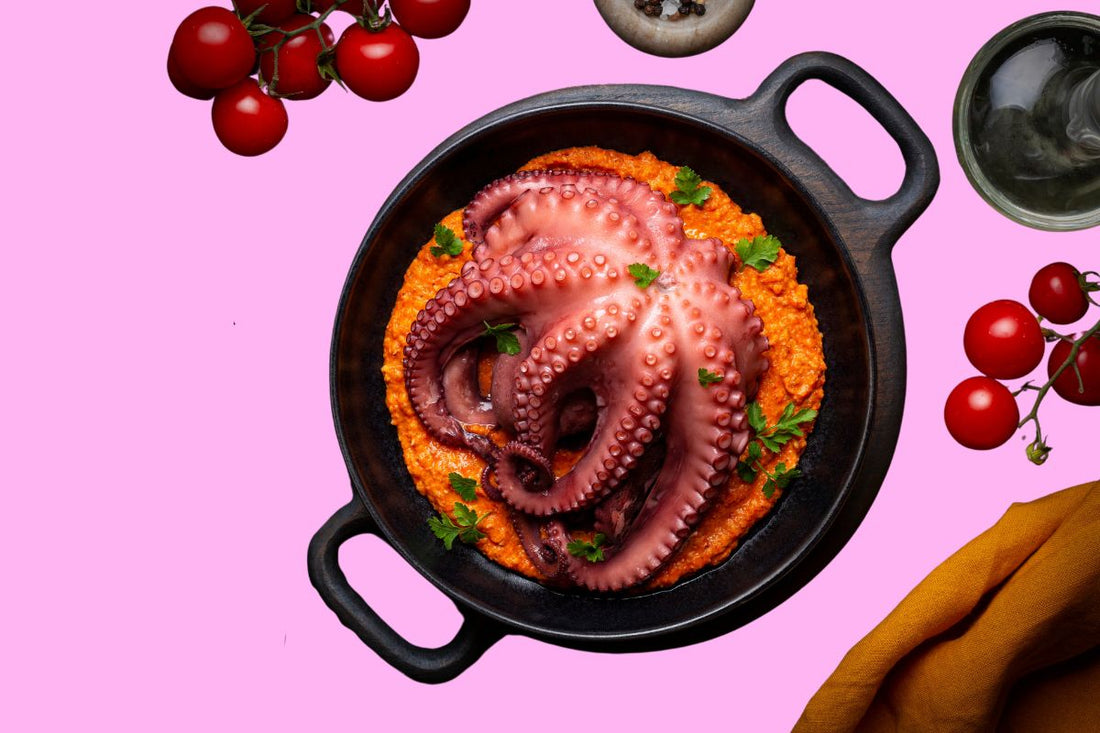Thawing Frozen Raw Octopus Ball 4-6:
Refrigerator Thawing (Recommended):
Place the frozen octopus balls in a container or on a plate, ensuring they are not stacked on top of each other.
Thaw them in the refrigerator for 8-12 hours or overnight. This method is the best for maintaining texture and flavor.
Once thawed, they can be stored in the refrigerator for up to 1-2 days before cooking.
Cold Water Thawing (Quicker Method):
Place the octopus balls in a sealed plastic bag to prevent water from getting in.
Submerge the sealed bag in a bowl of cold water.
Change the water every 30 minutes to keep it cold.
The octopus balls should thaw within 1-2 hours, depending on their size.
Cook them immediately after thawing for the best results.
Storing Frozen Raw Octopus Ball 4-6:
Freezing
Keep the octopus balls in their original packaging or wrap them tightly in plastic wrap or aluminum foil.
Place them in a freezer bag, remove as much air as possible, and seal tightly.
Store at 0°F (-18°C) or lower. Properly stored, they can last in the freezer for up to 6-8 months.
Refrigeration (After Thawing):
If you thawed the octopus balls in the refrigerator, you can store them in an airtight container.
Keep them refrigerated and use them within 1-2 days for optimal freshness.
Cooking Frozen Raw Octopus Ball 4-6:Boiling (Traditional Method):
Bring a large pot of salted water to a boil.
Add the thawed octopus balls to the boiling water.
Boil for 3-5 minutes or until they are fully cooked. The balls should be firm to the touch and have an opaque color.
Drain and serve hot with your preferred dipping sauce or as part of a larger dish.
Grilling:
Preheat your grill to medium-high heat.
Brush the thawed octopus balls with a little oil to prevent sticking.
Grill the octopus balls for 2-3 minutes per side, turning them carefully with tongs.
Cook until they develop a slight char and are heated through.
Serve immediately as an appetizer or in a seafood platter.
Pan-Frying:
Heat a skillet over medium heat and add a small amount of oil or butter.
Once the oil is hot, add the thawed octopus balls to the pan.
Fry them for 3-4 minutes, turning occasionally, until they are golden brown on all sides and cooked through.
Remove from the pan and drain on paper towels to remove excess oil before serving.
Baking:
Preheat your oven to 400°F (200°C).
Place the thawed octopus balls on a baking sheet lined with parchment paper.
Brush them lightly with oil or melted butter.
Bake for 10-12 minutes, flipping them halfway through, until they are cooked through and lightly browned.
Serve hot with lemon wedges or your favorite dipping sauce.
Serving Suggestions:
These octopus balls are delicious when served with a variety of sauces such as soy sauce, garlic butter, or spicy mayo.
They can also be added to salads, seafood platters, or served as an appetizer at your next gathering.
Tips and Tricks
Avoid Overcooking: Keep cooking times short to prevent toughness.
Marinate: Add flavor by marinating in olive oil, lemon juice, and herbs.
Pat Dry: Dry the octopus balls before cooking for better browning.
Season Well: Use plenty of seasoning to enhance the mild flavor.
Rest After Cooking: Let them rest briefly to retain juices.
Pair with Acidity: Serve with lemon or tangy sauces to balance flavors.
By following these detailed steps, you’ll ensure your octopus balls are thawed, stored, and cooked to perfection, bringing out their best flavor and texture.
FAQ
How to cook octopus tentacles?
Since the tentacles are already cooked, you can reheat them by grilling, pan-searing, or sautéing to add flavor and texture.
Can I grill the cooked octopus?
Our tender Spanish octopus tentacles can be seared on the grill for a light char and complemented with a bright olive oil and herb dipping sauce
Why is cooked octopus rubbery?
This collagen makes octopus flesh rubbery, at least initially. With enough heat and time that collagen breaks down into silky and tender gelatin, and the octopus grows tender with it. It's really no different than stewing gristly chunks of beef in a stew; eventually they become soft and tender.
How to cook frozen octopus tentacles?
If frozen, thaw the tentacles in the refrigerator overnight. Once thawed, reheat by grilling, pan-searing, or adding to your recipe as desired.
How long does it take to boil octopus tentacles?
For already cooked tentacles, you don't need to boil them again. Just reheat them by grilling, pan-searing, or adding to a hot dish.
How to cook octopus tentacles in a pan?
Heat a pan over medium-high heat with a bit of oil. Add the pre-cooked tentacles and cook for 3-5 minutes, turning occasionally, until they are heated through and crispy on the outside.

